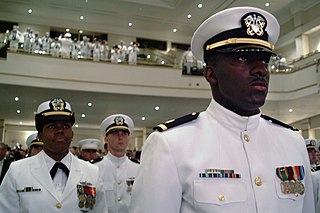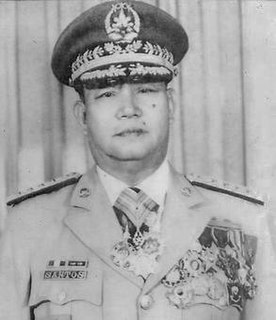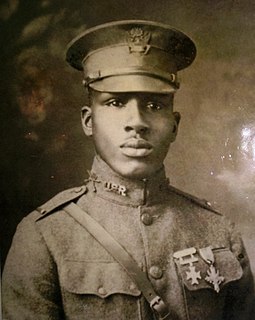
The Reserve Officers' Training Corps (ROTC) is a group of college- and university-based officer training programs for training commissioned officers of the United States Armed Forces.

The Texas A&M University Corps of Cadets is a student military organization at Texas A&M University. Established with the University in 1876, it is the oldest student organization on campus.

The Virginia Tech Corps of Cadets (VTCC) is the military component of the student body at Virginia Polytechnic Institute and State University. Cadets live together in residence halls, attend morning formation, wear a distinctive uniform, and receive an intensive military and leadership educational experience similar to that available at the United States service academies. The Corps of Cadets has existed from the founding of the Virginia Agricultural and Mechanical College in 1872 to the present-day institution of Virginia Tech, which is designated a senior military college by federal law. As of August 2021, about 1,200 cadets are currently enrolled in the program.

Exhibition drill is a variant of drill that involves complex marching sequences which usually deviate from drill used in the course of ordinary parades. Teams performing exhibition drill are often affiliated with military units, but the scope of exhibition drill is not limited to military drill teams. Exhibition drill is often performed by Armed Forces Precision Drill Teams, the drill teams at service academies and ROTC and JROTC units, and civilian drill teams that perform at parades, drill meets, and half-time shows and other public venues.

The awards and decorations of Civil Air Patrol are "designed to recognize heroism, service, and program achievements" of members of Civil Air Patrol (CAP) of the United States of America. The CAP is the official auxiliary of the United States Air Force. These awards are made to improve the esprit de corps of members. These awards are all worn in the form of medals or ribbons and all are considered civilian decorations. Civil Air Patrol regulations allow them to only be worn and displayed on appropriate CAP uniforms. In order to be considered for one of these awards, an individual must be a member in good standing of Civil Air Patrol at the time of the act being recognized. There is a statute of limitations for these awards and all recommendations must be submitted within 2 years of the act being performed. It is possible for the next of kin of deceased persons to be presented awards to which a member was entitled, but which he or she did not receive. Award review boards are established at the region, wing, group, and squadron levels to consider recommendations for all awards and decorations.
Benedictine Military School is an American Roman Catholic military high school for boys located in Savannah, Georgia, United States. It was founded in 1902 by the Benedictine monks of Savannah Priory, which still operates the school, under the auspices of the Roman Catholic Diocese of Savannah.

Alfredo Manapat Santos was Chief of Staff of the Armed Forces of the Philippines in 1962 to 1965, making him the first four-star general of the Philippines' armed forces.
Early Commissioning Program (ECP) is a U.S. Army ROTC program that allows graduates of one of the nation's four Military Junior Colleges (MJC) to become commissioned officers in the reserve components in two years, instead of the usual four. Upon completion at MJCs, ECP LTs must go on to finish a bachelor's degree before serving as active duty officers or continuing a career in the reserve components. They must graduate within the next 24 months after receiving early commission. While attending their 4-year university, ECP LTs will be serving in a non-deployable status.

The University of Oklahoma Army ROTC is the primary officer training and commissioning program at the University of Oklahoma and one of the oldest in the nation, having existed in some form since the First World War. It is known as the "Sooner Battalion" and is notable for having produced thousands of officers for the United States Army, including 19 general officers. It is led by three officers and two noncommissioned officers.

Scabbard and Blade (S&B) is a college military honor society founded at the University of Wisconsin in 1904. Although membership is open to Reserve Officers' Training Corps (ROTC) cadets and midshipmen of all military services, the society is modeled after the U.S. Army and its chapters are called companies and are organized into regiments in order of their establishment. It was founded as a men's organization, and is now a co-educational society. The Junior Program has opened membership to Junior Reserve Officers' Training Corps (JROTC) cadets and midshipmen as well, having to uphold the same standards as their collegiate counterparts.

The Superior Cadet Decoration Award is the second highest Department of the Army medal awarded exclusively to Reserve Officers' Training Corps cadets. This award is presented annually to the outstanding cadet in each year of Military Science at each of the respective ROTC units. As with other Department of the Army decorations, the award consists of a medal, ribbon, and lapel button with case, accompanied by DA Form 1773 signed by the regimental commander on behalf of the Secretary of the Army. In the Army, this award is also known as the Superior Cadet Decoration and the Superior Cadet Medal.

The Penn State Army Reserve Officers' Training Corps is the ROTC department at The Pennsylvania State University. It is the largest branch of the ROTC program at the school, which also has Naval ROTC and Air Force ROTC. The Penn State ROTC Battalion is one of the 41 participating battalions in the 2nd Reserve Officers' Training Corps Brigade, also known as the Freedom Brigade. The brigade is headquartered at Fort Dix, NJ, and comprises ROTC programs in the North Eastern United States including CT, MA, ME, NH, NJ, NY, PA, RI, and VT.
Awards and decorations of the Armed Forces of the Philippines are military decorations which recognize service and personal accomplishments while a member of the Armed Forces of the Philippines (AFP).

Aaron Richard Fisher was an American soldier. He served more than thirty years in the U.S. Army (1911–1947) and was a recipient of several military awards, most notably the Distinguished Service Cross and Purple Heart from the United States and the Croix de Guerre with gold star from the French government for actions in battle, while serving as a second lieutenant during World War I.
The National Defense Cadet Corps (NDCC) was the forerunner to the current Junior Reserve Officers' Training Corps (JROTC) program and is essentially identical to it with just one exception: The NDCC is funded internally by the schools that opt for a military training system like JROTC but without any financial assistance from the Department of Defense. Therefore, the schools bear all costs associated with the program, including military instructor salaries, uniforms, training materials, and any other program expenses. As of 2012, there were three remaining US Army NDCC units in the United States. The US Navy began its program in April 2011. The US Marine Corps and the US Air Force also operate NDCC programs.

The Army Reserve Officers' Training Corps (AROTC) is the United States Army component of the Reserve Officers' Training Corps. It is the largest Reserve Officers' Training Corps (ROTC) program which is a group of college and university-based officer training programs for training commissioned officers for the United States Army and its reserves components: the Army Reserves and the Army National Guard. There are 30,000+ Army ROTC cadets enrolled in 274 ROTC programs at major universities throughout the United States.

The Junior Reserve Officers' Training Corps is a federal program sponsored by the United States Armed Forces in high schools and also in some middle schools across the United States and at US military bases across the world. The program was originally created as part of the National Defense Act of 1916 and later expanded under the 1964 ROTC Vitalization Act.
Air Force Junior Reserve Officer Training Corps (AFJROTC) is a subdivision of the Junior Reserve Officer Training Corps (JROTC). JROTC is a junior military science elective class that is offered in many high schools across the United States. The class is the high school version of the college ROTC. The Air Force division of JROTC is composed of physical training, aerospace science academic classes, and leadership skill creation. Outside of the formal class, there are extra-curricular teams that cadets may participate in to create qualities of leadership and followership. Unlike the collegiate version of ROTC, upon completion of JROTC there is no military service required. This allows the youth of United States to experience the military without having long-term commitments.

The University of Santo Tomas Golden Corps of Cadets (UST-GCC) also referred to as the UST ROTC Unit is a Reserve Officers' Training Corps unit implementing one of the optional components of the Philippines' National Service Training Program (NSTP) in the University of Santo Tomas. The NSTP is a civic education and preparedness program for college students, the ROTC component of which aims to provide military education and training to mobilize them for national defense preparedness.
The Augusta-Central Savannah River Area (CSRA) Vietnam War Veterans Memorial is a granite and bronze monument placed in Augusta, Georgia, March 29, 2019, to honor the CSRA's 169 Vietnam War dead, three Ex-Prisoners of War (Vietnam), and one former Missing in Action (MIA) as well as the region's 15,000 surviving Vietnam War Veterans. The memorial is located in the "Olde Town" section of Augusta, Georgia, on the Broad Street median between Third and Fourth Streets. The monument was designed, purchased, and placed by the Augusta Chapter of the Military Order of the World Wars (MOWW) and the chapter's 17 community partners who made up the Augusta-CSRA Vietnam War Memorial Initiative (VWMI) Steering Committee.














